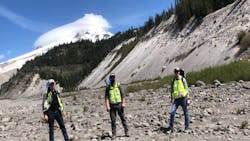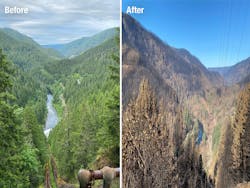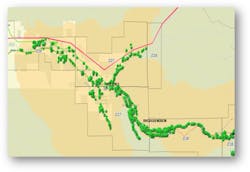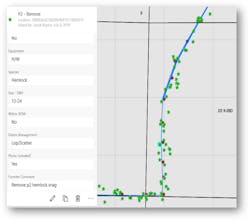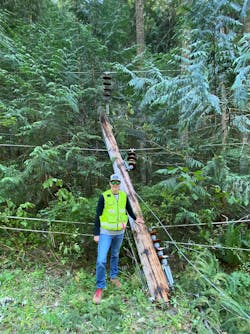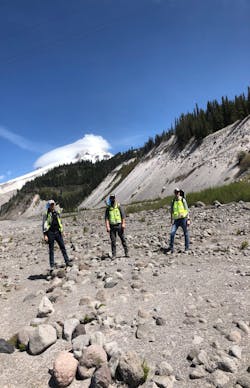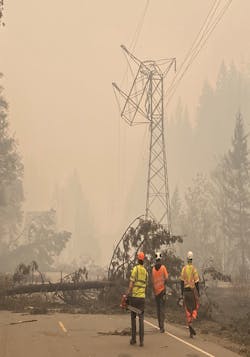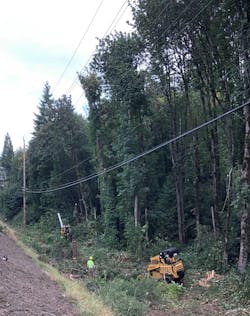Editor’s Note: Alex Konopka will also be presenting at the T&D World Black Sky Hazards and Grid Resilience Virtual Event Nov. 16-17, 2021. His session, titled “Wildfire Recovery: Vegetation Management Perspective,” will explore the immediate response/restoration efforts, while providing a deeper focus on the long-term recovery efforts that PGE Vegetation Management designed and implemented to ensure long-term reliability and reduce the impacts of climate events.
In the Pacific Northwest, there are often more trees than you can count, but utilities can now use digital solutions that leverage the data of individual trees. This digital strategy is combined with smart organizational structure, the right heavy equipment, skilled work crews and good relationships with land stakeholders to get the job done and keep crews safe and working productively.
In 2019, Portland General Electric’s (PGE) vegetation management team implemented its advanced wildfire risk reduction (AWRR) programming. This is a vegetation management program designed to reduce the risk and impacts of wildfire within PGE’s service territory through annual inspection cycles, prescriptive trimming and enhanced vegetation control techniques.
Some elements of the AWRR program were gleaned while working during the mutual assistance efforts with Pacific Gas & Electric during the 2018 Camp Fire. Communities that experience the effects of wildfires are never the same, and all who perform this work carry the memories with us.
My deployment to Paradise, California during the 2018 Camp Fire changed me, and I carry the emotion, loss, resilience and hope with me every day. Our work is meaningful and important to the community, and it is critical for utility and vegetation management crews to act with urgency and reverence.
Developing the Program
PGE’s AWRR program is supported by several operational and situational awareness tools and is the result of a dynamic partnership between stakeholders. PGE worked with the U.S. Forest Service, the Oregon Department of Forestry, the Bureau of Land Management as well as private and state
land-owners to develop this program.
It’s important for foresters, vegetation management leadership and all vendors and tree crews to have good working relationships with one another regardless of what digital solutions are used, but the strengths of these factors will come together and complement one another in a good vegetation management program.
With the understanding that the most important work ultimately happens in the field, PGE decided its digital solutions needed to reflect the operational pace. Trees are dropping every day out there, and we need situational awareness, digital tools and relationships to keep up at the pace that we operate.
The digital platform needed to be as close to real-time as possible while being as intuitive as any hand-held application you might use on a smart phone, yet as simple as possible to help get the right crews to the right locations. PGE vegetation management developed its own ArcGIS Collector application in-house, making it specific to AWRR activity.
Software collates and displays the data the utility already has, to build an application to track vegetation management work on a tree-by-tree basis with high data integrity and detailed chain of custody. PGE also uses a sister program called Quickbase that can automatically extract data from Collector and display it in a way that allows safety and productivity analyses.
This digital strategy lets the utility look at data based on area, crew, tree species, tree diameter and other tables that help steer the AWRR program in near real-time.
When developing a digital strategy, operational timeline must be a consideration. How will you get information out to tree crews, how is field training for in-house staff delivered, and how adjustments made as the strategy is rolled out? A good GIS analyst should be able to put this kind of digital strategy together quickly, and the software is intuitive enough that experienced tree-trimming crew leaders can learn how it works with few problems.
The program shows field crews the vital statistics of each marked tree, including its position in the right-of-way (ROW), its species, its size, what equipment to use on it, its location on a map and other data. From there, the tree crews use the program to update its status with data on what work was done, who did the work, when it was done and with what tools and methods.
The field rapidly adopted the solution, with experienced tree trimming crews picking up program functions quickly and using them to do their work more productively and safely.
The team also found that the real-time data tool eliminated the need for frequent coordination and inspection meetings and allowed stakeholders to gain better insight into utility work and goals.
Boots on the Ground
In PGE’s service territory, crews routinely deal with trees that are 150 feet to 180 feet tall, with diameters of 36 inches to 48 inches at chest level. These crews work on massive trees, and there are a demanding set of safety requirements crews must abide by to do their jobs safely while also working productively. It is important to identify workers who can exercise good safety culture even in a demanding environment.
Organizational structure is a fundamentally important aspect of PGE’s AWRR program and was one that guided much of the early development of the strategy. PGE has a robust in-house staff, led by a vegetation manager, a forestry manager and a forestry supervisor. PGE’s service territory of 4,000 square miles is divided into four regions with each one having a senior forester and an associate forester. Role clarity and line of sight are crucial supports to this program’s effectiveness and determines how the utility works with vendors, tree crews and partners.
The AWRR program is broken into two pieces. There is the annual activity, which is carried out in advance of fire season regardless of what other programs might be underway.
Tree risk categories are marked as Priority 1 or Priority 2 and categorized trees are physically marked with paint as well as tagged into the system. A Priority 1 tree is a hazardous growth posing imminent risk of falling onto a PGE overhead line within the designated public safety zone. A Priority 2 tree poses a fall-in or overstrike risk to overhead lines and shows signs of being unstable — lean, cracks, conks, root rot, codominant growth and other weaknesses.
These practices take potential “cycle busters,” or imminent threats to overhead mileage off the table as the utility heads into fire season. The second part of the program is ongoing vegetation maintenance, which involves tagging potential problem trees and expanding the utility’s database of vegetation. This occurs all year long, and ideally as the utility goes through its inspections, the list of problem trees will dwindle as off-right-of-way targets for removal are reduced.
In applying these standards, PGE looks beyond just dead and dying foliage, but also considers arboricultural factors such as a tree’s particular growth habit, the area’s prevailing winds, climate data such as plant moisture content and other factors when
determining targets.
Where herbicides are applied to right-of-way floors, PGE selects compounds that are not specifically for bare ground but uses integrated vegetation techniques to encourage desirable plant biomass that will be hardier during drought conditions and provide less dry fuel to fires.
PGE also deploys Jarraff tree trimming equipment in ROWs, which use 80-foot booms mounted with saw blades that articulate in 360 degrees to side-clear ROWs. This equipment is paired with ground crews to buck wood. This equipment can top trees, section trees down and expand ROWs, while a brushing unit follows behind to mulch vegetation, adding to the forest’s natural layer of duff, which is a forestry best practice in the Pacific Northwest.
Some crews employ a unit called the Slashbuster, which is a tracked excavator with a specialty head about four feet in diameter that can fell trees as well as grind entire trees down. The equipment requires an operator and a feller to run. This productive piece of equipment can turn in several hundred tree removals per week.
PGE vegetation management was able to apply these lessons to the unique contours of PGE’s own 4,000 square miles of service territory.
A Successful Strategy
One of the reasons AWRR implementation was successful is due to the intimate knowledge PGE’s team has of its own program, the industry, and how work crews perform in the field. An effective strategy is the culmination of all those aspects.
PGE’s understanding of local, state and federal agencies and their responsibilities has helped in ensuring good relationships and experiences with key stakeholders including the U.S. Forest Service, Oregon Department of Transportation and the Bureau of Land Management. PGE’s experience with related agency permits and agreements has also been extremely helpful.
PGE has great responsibilities as stewards of the urban and natural forest within its territory. The utility’s solutions should reflect a strong balance between promoting utility needs and advocating for the appropriate integrated vegetation management principles that lead to sustainable and reliable power line ROWs and infrastructure.
Since implementing the AWRR program in the second quarter of 2019, PGE has performed annual line patrols prior to the 2019, 2020 and 2021 fire seasons within PGE’s identified Public Service Safety Shutoffs (PSPS) zones. In total, the utility has identified over 12,500 trees for mitigation along over 780 overhead line miles subject to the AWRR programming.
Leaning In
This is a dynamic time in the utility vegetation management industry. Many individuals and entities look to the utility to lead and model the way forward. However, managing vegetation is a community-based effort, where our work is only one component of responsible land management.
Our customers and stakeholders have learned to trust in the professionalism and knowledge contained within utility vegetation management programs. This is a huge opportunity we have as we engage with customers, private landowners, municipalities, state and local agencies, and federal agencies. Utility vegetation management programs can lead and influence in the wildfire risk mitigation realm.
While we have learned a great deal about collaboration through the implementation and continued operation of AWRR, the most important take away has been to always be the biggest advocate of what is right, no matter how tough the road may be or how alone it may feel at the time. There are always multiple objectives and parallel tracks to any relationship, especially one as interesting as utility vegetation management.
Editor’s Note: Alex Konopka will also be presenting at the T&D World Black Sky Hazards and Grid Resilience Virtual Event Nov. 16-17, 2021. His session, titled “Wildfire Recovery: Vegetation Management Perspective,” will explore the immediate response/restoration efforts, while providing a deeper focus on the long-term recovery efforts that PGE Vegetation Management designed and implemented to ensure long-term reliability and reduce the impacts of climate events.
Alex Konopka is the senior manager of Vegetation Management at Portland General Electric. He has been with PGE since 2014 and has spent his entire PGE career within the Vegetation Management department. Konopka has his bachelor’s degree in landscape architecture from the University of Idaho and is active within the Vegetation Management industry, speaking at various industry events with T&D World and the Utility Arborist Association (UAA). Most recently, he was recognized in Public Utilities Fortnightly 2021 “Under Forty” feature for the development and implementation of PGE’s AWRR program.
About the Author
Alex Konopka
Alex Konopka is Senior Manager, Vegetation Management, Portland General Electric.
